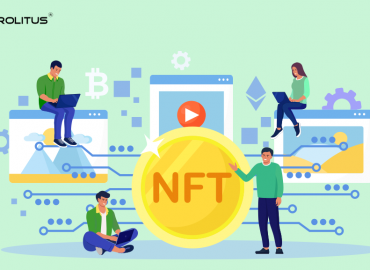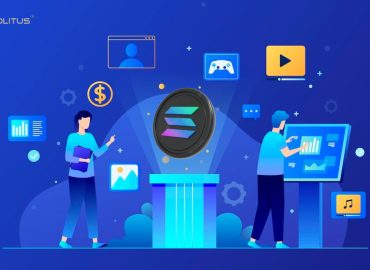The buzz around Blockchain technology and NFTs is skyrocketing at its peak with the increase in the usage of NFTs by many industries, including gaming, art and music, fashion, and many more. With this trend in place, NFT marketplaces are also on their way to bringing a new revolution to the entire world.
Many blockchain networks in the current market offer NFT marketplace developments like Ethereum, Solana, TRON, Binance Smart Chain, Cardano, Avalanche, etc. But among these blockchains, Ethereum has ruled the entire NFT marketplace for a long time because it’s the default blockchain preferred by developers.
This scenario is now changing as Ethereum is quickly losing its preference to other blockchains like Avalanche because they offer better features compared to Ethereum and also overcome some of the major issues faced by the Ethereum blockchain.
Thus, in this article, we will cover everything about the NFT marketplace and its development using Avalanche.
So let’s get started.
Top Features of the NFT Marketplace
Below are some of the most crucial features offered by the NFT marketplace:
- Ownership Rights
- Decentralization
- Robustness
- High Scalability
- Rareness
- Highly secure trade of NFTs.
- Interoperability
- Transparency
Now that you have understood the features, let’s jump onto the step-by-step for developing the NFT marketplace on Avalanche.
A Step-by-step Guide for Developing a Marketplace on Avalanche
Below is the guide that will help you develop an NFT marketplace on Avalanche. So let’s go through each step one by one.
Step 1: Conduct Extensive Market Research and Planning
The very first step should always be doing in-depth market research and planning. The following things need to be carried out for sure:
- Know your target audience.
- Collect the maximum amount of information about the market.
- Keep a note of your competitors’ strengths and weaknesses.
- Make a checklist of what features and factors you need in your NFT marketplace.
Step 2: UI/UX Design
The two most essential features of designing an NFT marketplace are the User Interface (UI) and User Experience(UX). The marketplace design should be robust, appealing, interactive, and responsive to grab the audience’s attention while navigating other NFT marketplaces. Along with that, you should also check the design of Avalanche’s stimulation monitors to ensure that the aim and feel of the design are what was expected and, if not, incorporate the changes to achieve it.
Step 3: Create a Marketplace
Now that the market research and UI/UX design are done, it’s time to develop the Avalanche NFT marketplace. This broadly involves writing codes in high-level languages. Here you will need to take help from experts and give a fair amount of time and effort so that things work out as per the requirements.
At this step, you can also use customized or white-label NFT marketplace development services to meet specific business needs.
Step 4: Testing the Developed NFT Marketplace
What you will need to do before actually launching the NFT marketplace is perform rigorous testing. This step plays a significant role in finding any pitfalls, defects, or flaws in the NFT marketplace, and if any are found, they need to be fixed as soon as possible. In addition to that, continuous testing rounds, as we just talked about, need to be repeated until it is rest assured that no more anomalies are present.
Step 5: Open The NFT Marketplace
Finally, after all, things are in place, and you are ready to launch your Avalanche NFT marketplace on either mobile or website, or even at both places.
Here, you shouldn’t forget to keep an eye on the number of users and any feedback they give. You should also test the marketplace every so often to make sure it works well. Some good feedback from the users should also be incorporated, and the marketplace should be updated from time to time as and when necessary.
The Benefits of Developing an NFT Marketplace Using Avalanche
There are various benefits to developing an NFT marketplace using Avalanche, but in this section, we will cover some of the most prominent ones.
High TPS and low latency
One of the most significant benefits of the Avalanche NFT marketplace is that the transactions are processed at a very high speed. As a result, roughly 5000 transactions are processed per second, keeping the finality time below the 1-second mark.
This also makes it possible for Avalanche to attract more futuristic NFT applications like retail domain, daily trading, etc.
Eco-Friendly
The Avalanche blockchain uses Proof-of-Stake (POS) as its consensus mechanism, making it more energy efficient than the Ethereum blockchain, which uses Proof-of-Work (POW).
Although Ethereum is ruling the NFT marketplace, it is also facing backlash from critics due to its high energy consumption, and that’s where Avalanche has immense potential to expand and grab the market share.
Scalable and decentralized
The Avalance NFT marketplace has also taken care of scalability and decentralization because, as its user base grows, the NFT marketplace on Avalanche can be scaled to any degree and is highly decentralized. In addition to that, there is a unique feature on the portal which allows individual users to trade NFTs among themselves, making it independent of the owner and even more decentralized.
Highly adaptive
One of the biggest threats an NFT marketplace may face is from hackers. But with the Avalanche NFT marketplace, this isn’t possible as it uses Snow Protocol.
With the help of this protocol, Avalanche can withstand small-scale attacks very easily, and even from large-scale attacks, it can quickly recover, thus working effectively in any situation.
Safe from Double-spending
Double spending is also a big headache for the NFT marketplace due to its high risks. But with the help of Snow Protocol, the Avalanche NFT marketplace ensures that double spending does not take place under any circumstances.
Permissionless and robust,
Due to the public blockchain aspect of Avalanche, which eliminates the need for the owner to be familiar with every user, an Avalanche-based NFT marketplace is more potent and less wasteful of resources.
Final Thoughts
Building an NFT marketplace is incredibly profitable because NFTs are causing a stir in today’s society. As you have already learned a lot about the NFT marketplace and how it can be built using Avalanche, there should be no doubt hovering in your mind. So if you are also planning to build a white-label multi-chain NFT marketplace, why don’t you reach out to Prolitus, a leading blockchain development company in the crypto space?
We at Prolitus have a team that comes with enriched experience and expertise in the field of developing a white-label multi-chain NFT marketplace. Our highly skilled blockchain developers can also help you design and align the NFT marketplace based on your business objectives.
Still thinking about what to do?
Just contact us, and let our experts handle all your doubts.
FAQs
Q1: Is the NFT marketplace even profitable?
Answer: Yes, of course. There is no doubt in the fact that the NFT marketplace is a profitable business. If you have some great ideas in your mind, you just need help from experts who can help you develop the NFT marketplace.
Q2: How can I launch my own NFT Marketplace?
Answer: Simple. Get in touch with us, and our experts will help you with every step towards making your own NFT Marketplace.
Q3: What is the cost of developing an NFT marketplace?
Answer: To be honest, there is no specific number for this, but it roughly ranges from $100-500K to develop an NFT marketplace. The cost also varies a lot due to its dependency on the platform, tools, technology, complexity, etc.
Q4: Which is the best company for NFT Marketplace development?
Answer: Don’t take our word for it. Just try out our services, and we’ll let you decide.
Q5: What exactly is the NFT Stars market?
Answer: NFT Stars is one of the top Avalanche NFT marketplaces. It is a marketplace that enables the liquidity flow of NFTs on multiple blockchains. The project’s objective is to educate more market participants about non-fungible tokens and the advantages they offer.
Q6: What is the market cap of the entire NFT marketplace?
Answer: According to the latest data as of June 30, 2022, the NFT projects listed on OpenSea and available on the Ethereum blockchain are in total worth around $840 million.





